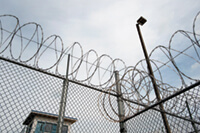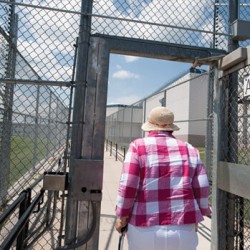What goes on inside a prison’s fences
You never know where a story might take you.
In the case of Stacy Forster, reporting this issue’s “Opening the Door to Forgiveness” took her to prison.
In late 2009, Forster met with Pete DeWind ’82, JD’90, director of the UW’s Restorative Justice Project, which facilitates meetings between crime victims and their perpetrators. She knew that observing a meeting firsthand was the best way to tell the story, and she checked with him monthly for prospects.
An opportunity surfaced in April at a minimum-security prison just outside Madison. The victim and offender were both on board with Forster and University Communications photographer Jeff Miller attending their meeting, but a few days before the scheduled visit, the prison said no.
As Forster searched for plan B, she interviewed Jackie Millar, who had been shot in the back of the head during an armed robbery. Millar mentioned an upcoming meeting with the shooter, Craig Sussek, at a medium-security prison 180 miles northwest of Madison. Both Millar and Sussek agreed to allow Forster and Miller to attend, and officials at Stanley Correctional Institution gave their okay just one week before the meeting.
But the hurdles didn’t end there. Forster and Miller had to provide their full names, dates of birth, and a detailed list of what they would be bringing with them. For Forster, it was simple: digital voice recorder (with AAA battery inside), pen, and notebook. For Miller, it was a bit more complicated: two digital cameras, lenses, memory cards, and other photographic equipment. Upon arrival, both had to present driver’s licenses, walk through a metal detector, and surrender personal items. A handkerchief Miller was carrying to contend with his allergies was a no-go.
To get from the prison’s front door to the small break room where Millar and Sussek met, the pair walked through twelve doors and gates, including several auto-locking doors surrounded by razor wire.
What they then witnessed inside was a remarkable portrayal of forgiveness and healing.
Both Forster and Miller say that being there was a privilege — not something you expect to hear from people who went to prison.
Published in the Winter 2010 issue




Comments
No comments posted yet.